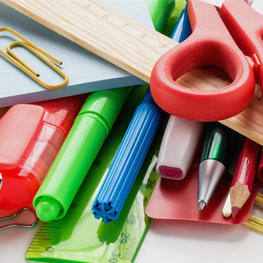
If you are like me, you may have discovered that although you have the best of intentions, you fall behind as soon as the hustle and bustle of a new school year begins. Don’t become frustrated, overwhelmed, or throw in the towel. Instead, follow these organizational tips for a smooth school year that have worked for me and other parents year after year.
Create ‘command central’
In our home, command central is in the kitchen. We congregate here for breakfasts and dinners, so this space works best for us. Our command central consists of a master calendar, a file box with folders, and several drawers for school supplies. Our file box contains a file for me and for each of my kids. I staple lined paper to the front of each folder. The lined paper is for important dates and reminders. These are checked off when they are completed. The folders also hold back-to-school night information such as class lists and rules, permission slips for field trips, exams, quizzes, artwork, and other correspondence from teachers.
I go through each folder at the end of the term, adding the no-longer-needed paperwork to our recyclables. I hold on to any artwork until the end of the school year and make a decision, with the help of each child, on what to keep and add to their keepsake bin.
Create a master calendar
I like being able to add the entire school year’s important dates for school and extracurricular commitments as soon as they are available. This helps immensely with planning and avoiding scheduling conflicts.
Each of my kiddos is assigned a color for the master calendar. The color matches their file folder. Red is reserved for me because it signals ‘priority’ - like keeping an eye on my child’s performance in a certain subject they find challenging or paying for school pictures. As far as the type of master calendar you should use, I prefer a large calendar, one which I can add my kids’ names to. Their names appear when I flip to the coming month.
Even in this era of great organizational apps, I prefer using a physical calendar. The master calendar is a great visual for helping kids understand and appreciate the dynamics of pulling together as a family to make things run as smoothly as possible. Kids can view their school project due dates and exam dates; doctor, dentist, and orthodontist appointments; social events, like sleepovers; extracurricular activities, like sporting events; and school breaks.
The colored markers are kept in a pencil holder close to the master calendar, duct-taped and marked ‘MC’ in permanent black marker so they are returned to command central if inadvertently taken.
Go through last year’s leftovers
Consider the school supplies that can be reused/ recycled, donated, or disposed of. What supplies do you have? What is the condition of last year’s leftovers? Are your glue sticks dried out? What are you out of? Have the dry erase markers gone AWOL? What do you need? Make a shopping list. Replenish.
Organize the supplies in the drawers so that they can be easily found. Consider buying dividers that fit into the command central drawers to separate extra pens, notebook paper, notebooks, folders, binders, binder dividers, sheet covers, note cards, highlighters, pens, pencils, colored pencils, crayons, glue, erasers, rulers, dry erase markers, permanent markers, sticky notes, paper clips, rubber bands, and more.
Dedicate space for a homework station
We had a dedicated homework area close to the kitchen until our kids were old enough to do their homework independently. While preparing dinner, I encouraged my kids to focus on and complete their homework until they could do it without my cheerleading. Now they all do their homework at their desks in their bedrooms.
Go over online safety, and check in with your kids regularly. Many children are expected to be online for homework and research. The Web is wonderfully accessible and easy to use, but potential hazards lurk everywhere.
Prepare for school the night before and take advantage of weekends
My kids are sleepy heads. They race against the clock every morning as they eek out the last minutes of shut- eye. They arrive at the breakfast table half asleep. To combat this, my kids shower and lay their clothes out the night before. They also ready their backpacks and sports bags the night before, along with their shoes and jackets, if necessary. What do they pack? Homework, fully-charged laptops, clean and empty water bottles, fruit and other snacks, and the needed, clean athletic gear.
If my kids forget something - and they often do - it is typically in the vicinity of command central. And they can grab it easily because it’s all organized; their confusion and stress are reduced.
On the weekends, I do laundry. I also create meal plans with the enthusiastic input of my kids. We take a look at the week ahead so we can visualize, talk about, and plan each day’s meals. But some weeks are busier than others, so we go over our organizational tools and tweak where needed.
Remember the following benefits of being organized while you are in the process of implementing and honing your organizational tools:
Organization is key in helping you minimize or alleviate the stress of keeping up with your child’s chaotic schedule of schoolwork and extracurricular activities. You will discover these tips to be even more helpful if you have more than one child.
Judy Miller, MA, is a freelance writer, a Certified Gottman Educator, and a mom to four children, who all have decent organizational skills. She is the author of What To Expect From Your Adopted Tween and Writing to Heal Adoption Grief: Making Connections & Moving Forward.
Calgary’s Child Magazine © 2024 Calgary’s Child